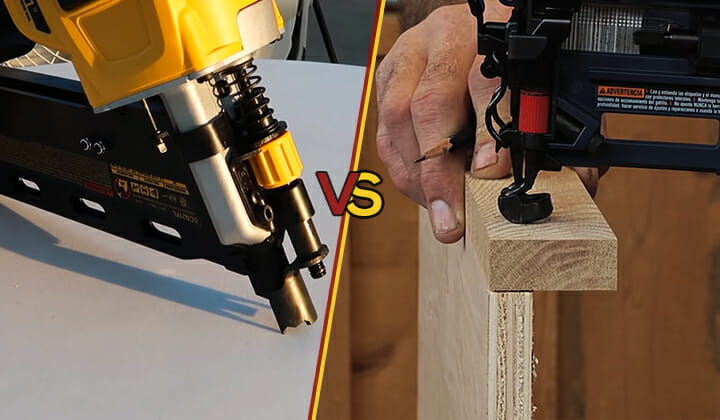Nailer magazine capacity differences matter for your projects. A larger capacity means fewer reloads, boosting efficiency for tasks like framing or decking. Smaller capacities are lighter and easier to maneuver for trim work. Choosing the right one saves time and frustration.
Getting the right nailer for your DIY project can make all the difference. It’s like having the perfect tool in your toolbox – it just makes the job easier and more enjoyable. One common question that pops up, especially when you’re starting out, is about how many nails a nailer can hold, also known as its magazine capacity. This might seem like a small detail, but it can actually impact how smoothly and quickly you get your work done. Don’t worry, we’re here to break down exactly what nailer magazine capacity means, why the differences are important, and how to pick the best one for your next project. We’ll cover everything you need to know to make an informed choice that will save you time and help you build with confidence.
And speaking of making informed choices, understanding the different types of nailers is also super helpful! For instance, learning about framing nailers can give you a good idea of the power and capacity geared towards larger jobs.
Table of Contents
What is Nailer Magazine Capacity?
Simply put, nailer magazine capacity refers to the maximum number of nails that a specific nailer’s magazine (the part that holds the nails) can hold at one time. Think of it like the magazine on a firearm, but for fasteners! The nails are typically lined up neatly inside, ready to be fed into the firing mechanism one by one as you pull the trigger.
This capacity can vary significantly from one type of nailer to another, and even between different models within the same category. It’s a specification you’ll find listed on the tool’s packaging, in its manual, and in product descriptions online. Understanding this number is key to knowing how often you’ll need to stop and reload, which directly affects your workflow.
Why Nailer Magazine Capacity Differences Matter
You might be wondering, “How much difference can a few nails really make?” The answer is, quite a lot! The capacity of your nailer’s magazine plays a crucial role in several aspects of your project:
- Efficiency and Speed: This is the biggest one. Imagine you’re building a deck or framing a wall. You’ll be driving hundreds, even thousands, of nails. If your nailer holds only 50 nails, you’ll be stopping to reload every few minutes. A nailer that holds 100-150 nails will let you work for much longer stretches without interruption, keeping your momentum going and finishing the job faster.
- Ergonomics and Weight: Generally, nailers with larger magazine capacities tend to be a bit larger and heavier because they need more space to store more nails. For quick trim jobs or working overhead, a lighter tool with a smaller magazine might be more comfortable to handle for extended periods. Conversely, for heavy-duty tasks, the slightly larger size of a high-capacity nailer might be a worthwhile trade-off for fewer reloads.
- Project Type Suitability: Different projects demand different approaches. Detailed trim work or intricate furniture construction often requires precision and can benefit from a lighter, more maneuverable tool, even if it means more frequent reloading. Large-scale jobs like framing houses, building fences, or installing siding demand continuous fastening, making a high-capacity nailer a much more practical choice.
- Cost: Sometimes, higher capacity doesn’t directly correlate to higher cost, but it’s worth noting that specialized, high-capacity nailers for specific applications (like roofing nailers) might have different price points. However, for common categories like framing or finish nailers, capacity is often a standard feature that impacts choice more than price directly.
So, the difference in capacity isn’t just a number; it’s a factor that influences how you work, how comfortable you are, and how effectively you complete your tasks. It’s about choosing the right tool for the right job to make DIY more achievable and less of a hassle.
Understanding Nailer Types and Their Typical Capacities
Nailers aren’t all built the same, and their intended uses dictate their typical magazine capacities. Let’s break down some common types:
Framing Nailers
These are the heavy-duty workhorses of the nailer world. Designed for structural work like building walls, decks, and fences, framing nailers drive larger nails (typically 2-3.5 inches long) with significant power. Because you’re driving so many nails into thick lumber, efficiency is key.
- Typical Capacity: 60-150 nails. Some models can hold even more.
- Nail Size: 2” to 3-1/2”
- When to Use: All structural framing, subflooring, deck building, fence construction.
Finish Nailers
Finish nailers handle smaller, thinner nails (usually 1.5 to 2.5 inches long) that leave a smaller hole, making them ideal for projects where appearance matters. They’re used for installing trim, molding, baseboards, and cabinetry. Precision and a clean look are the goals here.
- Typical Capacity: 100-150 nails.
- Nail Size: 1-1/4” to 2-1/2”
- When to Use: Installing trim, baseboards, crown molding, window and door casings, decorative molding.
Brad Nailers
Brad nailers are even more delicate than finish nailers. They use very slim brad nails (often 3/4 inch to 1.5 inches) that are almost invisible once inserted and are excellent for holding small pieces together while glue dries or for very light decorative work.
- Typical Capacity: 100-170 nails.
- Nail Size: 3/4” to 1-1/2”
- When to Use: Assembling small wood crafts, attaching thin molding, securing delicate trim pieces, upholstery projects.
Pin Nailers
The most delicate of the bunch, pin nailers use headless pins (0.5 to 1 inch long). These are practically invisible and are used for the most precise, low-stress applications where you don’t want any visible fastener marks, like delicate furniture restoration or attaching very small, light trim.
- Typical Capacity: 150-200+ nails.
- Nail Size: 1/2” to 1”
- When to Use: Attaching thin decorative trim, model making, delicate wood repairs, picture framing.
Other Specialty Nailers
There are many other nailers designed for specific tasks, and their capacities will align with their intended use:
- Roofing Nailers: Built for speed and durability on steep surfaces, these often have capacities around 100-120 nails for shingles.
- Siding Nailers: Similar to framing nailers in power but designed for specific siding materials, capacities can range from 75-150 nails.
- Concrete/Insulation Nailers: These might have smaller capacities as they often drive fewer, specialized fasteners into harder materials.
The key takeaway is that the nailer’s design and intended use heavily influence its magazine capacity. This helps us understand why different nailers are a better fit for different jobs.
Factors Affecting Magazine Capacity
Beyond the type of nailer, several other factors influence how many nails fit into that magazine:
- Nail Size and Gauge: Longer nails and thicker gauges (lower numbers) take up more space. A framing nailer’s magazine will be designed to accommodate these larger fasteners, while a pin nailer’s magazine is optimized for tiny, thin pins.
- Magazine Angle: Nailers have different magazine angles (e.g., 28°, 21°, straight). The angle can affect how compactly the nails stack and how the magazine is shaped, which in turn can slightly impact capacity.
- Nail Collating Type: Nails are held together in the magazine by paper strips, plastic collation, or wire collation. The type and thickness of this collation material can influence how tightly and how many nails can be loaded.
- Magazine Design and Loading Mechanism: The overall design of the magazine, including its width and how the driving mechanism pushes nails forward, can also contribute to how many nails can be securely held in place.
How to Choose the Right Nailer Magazine Capacity
Picking the perfect nailer capacity is all about matching your tool to your task. Here’s a simple thought process I use to decide:
1. Assess Your Project(s)
What kind of work will you be doing most often?
Big, repetitive tasks (framing, decks, fences): You’ll want a higher capacity to keep working uninterrupted. Think 100+ nails.
Detailed or intermittent tasks (trim, molding, small crafts): A moderate to high capacity is usually fine (100-150), but sometimes a lighter tool with slightly less capacity is worth it for maneuverability.
Very small or delicate tasks (miniatures, invisible finishing): Capacity might be less critical than the precision and minimal marking of the nailer itself. Lighter tools with good capacity (100+) are still great.
2. Consider Your Workflow
How much do you mind stopping to reload?
Hate interruptions: Go for the highest capacity you can find for your chosen nailer type.
Tolerate occasional breaks: A standard capacity (75-150) will likely be perfectly adequate.
Working in tight spaces: A smaller magazine that keeps the tool compact might be worth the extra reloads.
3. Think About Ergonomics and Weight
Will you be using the nailer for hours at a time?
Long work sessions, large projects: A slightly heavier nailer with a larger capacity might be more efficient overall.
Short bursts, overhead work, tight angles: A lighter nailer, even with a slightly smaller capacity, might be more comfortable and easier to control. The best capacity is one that doesn’t tire you out unnecessarily.
4. Material and Nail Type
What kind of nails will you be using?
Thick lumber, long nails: These are typically used with framing nailers, which inherently have higher capacities.
Thin trim, small brads: These often use nailers with good capacity numbers, but the overall tool size is smaller and lighter.
Practical Examples and Comparisons
Let’s look at how capacity plays out in real terms.
Scenario 1: Building a Deck
You’re laying down deck boards and attaching joist hangers to a large deck. This involves driving hundreds of nails into pressure-treated lumber. A framing nailer with a capacity of 120 nails means you might reload 5-10 times during this process, depending on the exact size of your deck. If you opted for a framing nailer with a capacity of only 60 nails, you’d be doubling your reloading stops, significantly slowing down your progress. For this task, bigger is definitely better for efficiency.
Scenario 2: Installing Baseboard Trim
You’re adding new baseboards to a living room and dining room. You’ll be driving finish nails into studs at intervals. A finish nailer with a capacity of 100 nails is common. This means you might reload 5-8 times for the entire job, depending on the room size. While some finish nailers might hold slightly more or less, the difference between 100 and 150 nails per load might not feel as critical here as the tool’s balance, the size of its head, and the ease with which you can get into corners. The key is a tool that feels good in your hand and makes accurate placements easy, with a capacity that doesn’t become an annoyance.
Scenario 3: Crafting a Small Wooden Box
You’re building a charming wooden box for gifts. You might use a brad nailer to hold pieces together while the glue sets. A brad nailer with 150 nails capacity means you could potentially complete the entire box (or several small boxes) without reloading. This is great because it allows you to focus on precise alignment and gluing without interruption. The lightweight nature favored for these tasks often comes with a good number of nails per load.
Here’s a quick way to visualize the trade-offs:
| Nailer Type | Typical Capacity Range | Pros of Capacity Choice | Cons of Capacity Choice |
|---|---|---|---|
| Framing Nailer | 60-150 nails | Fewer reloads for large jobs, consistent workflow. | Can be heavier, bulkier. Might be overkill for small tasks. |
| Finish Nailer | 100-150 nails | Good balance of reload frequency and maneuverability. | Higher capacity models can be a bit heavier. |
| Brad Nailer | 100-170 nails | Often lightweight, good for a variety of smaller tasks. | Not suitable for heavy-duty work. |
| Pin Nailer | 150-200+ nails | Extremely lightweight, minimal visual impact, very few reloads for their intended use. | Only for very light-duty, non-structural applications. |
Maximizing Your Nailer Experience
Once you’ve chosen a nailer with a magazine capacity that suits your needs, there are a few tips to make sure you’re getting the most out of it:
- Use the Right Nails: Always use the nail size, type, and brand recommended by your nailer’s manufacturer. Using incorrect nails can lead to jams, poor performance, or even damage to the tool. Always check resources like the Occupational Safety and Health Administration (OSHA) guidelines for safe tool operation, especially when dealing with power tools.
- Load Correctly: Follow the manufacturer’s instructions for loading the magazine. Overloading or improperly loading can cause jams and wear down your tool.
- Proper Maintenance: Keep your nailer clean and lubricated (if it’s an air-powered model that requires it). A well-maintained tool will perform better and last longer. For pneumatic tools, ensuring you have a clean, dry air supply is crucial for longevity.
- Practice Reloading: Even with a large capacity, you will eventually need to reload. Practice loading your nailer when you’re not under pressure. This way, when you’re in the middle of a project, you can do it quickly and efficiently.
- Have Spares Ready: Keep a box of the correct nails and any necessary accessories (like O-rings or maintenance oil for pneumatic models) nearby, so you’re prepared for quick fixes or reloads.
Frequently Asked Questions About Nailer Magazine Capacity
Q1: Will a larger magazine make my nailer too heavy?
Generally, yes, larger magazines do add some weight and bulk. However, the difference is usually manageable. For heavy-duty tasks like framing, the slight increase in weight is often less important than the extended work time. For lighter tasks, you might opt for a model with a good, but not excessively large, capacity to keep the tool light and maneuverable.




